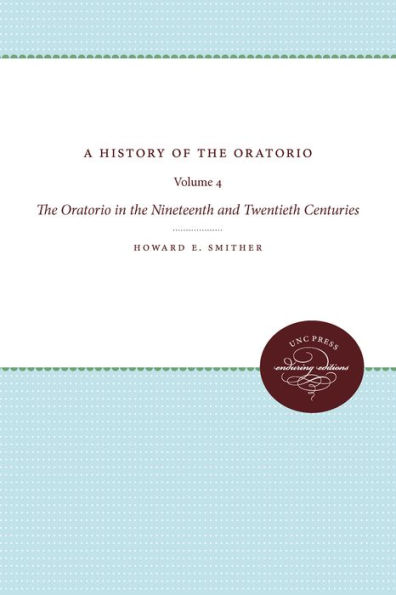A History of the Oratorio: Vol. 4: The Oratorio in the Nineteenth and Twentieth Centuries
With this volume, Howard Smither completes his monumental History of the Oratorio. Volumes 1 and 2, published by the University of North Carolina Press in 1977, treated the oratorio in the Baroque era, while Volume 3, published in 1987, explored the genre in the Classical era. Here, Smither surveys the history of nineteenth- and twentieth-century oratorio, stressing the main geographic areas of oratorio composition and performance: Germany, Britain, America, and France.
Continuing the approach of the previous volumes, Smither treats the oratorio in each language and geographical area by first exploring the cultural and social contexts of oratorio. He then addresses aesthetic theory and criticism, treats libretto and music in general, and offers detailed analyses of the librettos and music of specific oratorios (thirty-one in all) that are of special importance to the history of the genre.
As a synthesis of specialized literature as well as an investigation of primary sources, this work will serve as both a springboard for further research and an essential reference for choral conductors, soloists, choral singers, and others interested in the history of the oratorio.
Originally published 2000.
A UNC Press Enduring Edition -- UNC Press Enduring Editions use the latest in digital technology to make available again books from our distinguished backlist that were previously out of print. These editions are published unaltered from the original, and are presented in affordable paperback formats, bringing readers both historical and cultural value.
1129326317
Continuing the approach of the previous volumes, Smither treats the oratorio in each language and geographical area by first exploring the cultural and social contexts of oratorio. He then addresses aesthetic theory and criticism, treats libretto and music in general, and offers detailed analyses of the librettos and music of specific oratorios (thirty-one in all) that are of special importance to the history of the genre.
As a synthesis of specialized literature as well as an investigation of primary sources, this work will serve as both a springboard for further research and an essential reference for choral conductors, soloists, choral singers, and others interested in the history of the oratorio.
Originally published 2000.
A UNC Press Enduring Edition -- UNC Press Enduring Editions use the latest in digital technology to make available again books from our distinguished backlist that were previously out of print. These editions are published unaltered from the original, and are presented in affordable paperback formats, bringing readers both historical and cultural value.
A History of the Oratorio: Vol. 4: The Oratorio in the Nineteenth and Twentieth Centuries
With this volume, Howard Smither completes his monumental History of the Oratorio. Volumes 1 and 2, published by the University of North Carolina Press in 1977, treated the oratorio in the Baroque era, while Volume 3, published in 1987, explored the genre in the Classical era. Here, Smither surveys the history of nineteenth- and twentieth-century oratorio, stressing the main geographic areas of oratorio composition and performance: Germany, Britain, America, and France.
Continuing the approach of the previous volumes, Smither treats the oratorio in each language and geographical area by first exploring the cultural and social contexts of oratorio. He then addresses aesthetic theory and criticism, treats libretto and music in general, and offers detailed analyses of the librettos and music of specific oratorios (thirty-one in all) that are of special importance to the history of the genre.
As a synthesis of specialized literature as well as an investigation of primary sources, this work will serve as both a springboard for further research and an essential reference for choral conductors, soloists, choral singers, and others interested in the history of the oratorio.
Originally published 2000.
A UNC Press Enduring Edition -- UNC Press Enduring Editions use the latest in digital technology to make available again books from our distinguished backlist that were previously out of print. These editions are published unaltered from the original, and are presented in affordable paperback formats, bringing readers both historical and cultural value.
Continuing the approach of the previous volumes, Smither treats the oratorio in each language and geographical area by first exploring the cultural and social contexts of oratorio. He then addresses aesthetic theory and criticism, treats libretto and music in general, and offers detailed analyses of the librettos and music of specific oratorios (thirty-one in all) that are of special importance to the history of the genre.
As a synthesis of specialized literature as well as an investigation of primary sources, this work will serve as both a springboard for further research and an essential reference for choral conductors, soloists, choral singers, and others interested in the history of the oratorio.
Originally published 2000.
A UNC Press Enduring Edition -- UNC Press Enduring Editions use the latest in digital technology to make available again books from our distinguished backlist that were previously out of print. These editions are published unaltered from the original, and are presented in affordable paperback formats, bringing readers both historical and cultural value.
29.99
In Stock
5
1

A History of the Oratorio: Vol. 4: The Oratorio in the Nineteenth and Twentieth Centuries
856
A History of the Oratorio: Vol. 4: The Oratorio in the Nineteenth and Twentieth Centuries
856
29.99
In Stock

Product Details
| ISBN-13: | 9780807837788 |
|---|---|
| Publisher: | The University of North Carolina Press |
| Publication date: | 09/01/2012 |
| Sold by: | Barnes & Noble |
| Format: | eBook |
| Pages: | 856 |
| File size: | 12 MB |
| Note: | This product may take a few minutes to download. |
About the Author
What People are Saying About This
From the B&N Reads Blog
